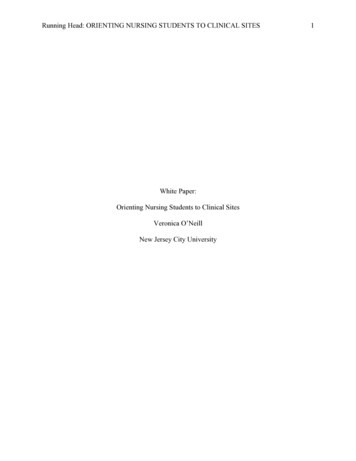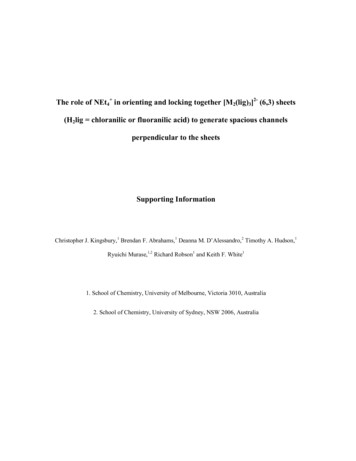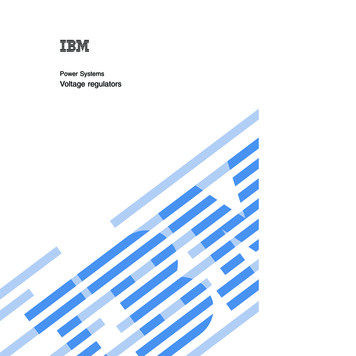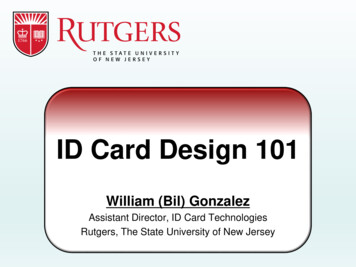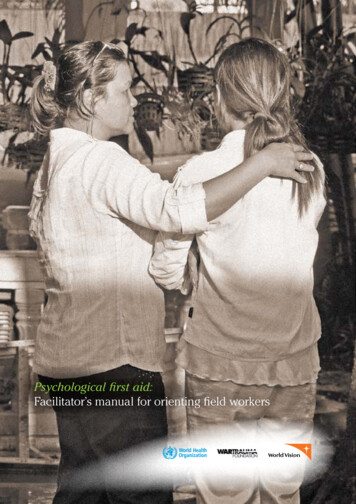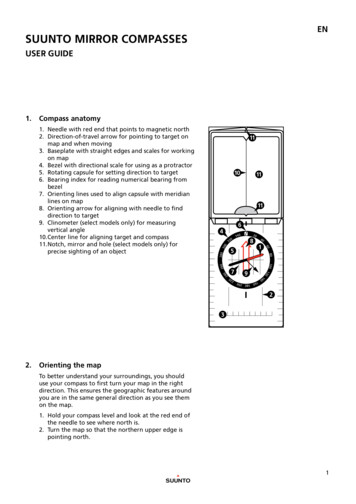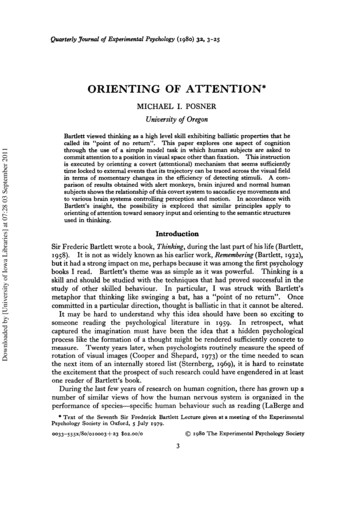
Transcription
QuarterlyJournal of EJrperimental Psychology (1980)32, 3-25ORIENTING OF ATTENTION*MICHAEL I. POSNERDownloaded by [University of Iowa Libraries] at 07:28 03 September 2011University of OregonBartlett viewed thinking as a high level skill exhibiting ballistic properties that hecalled its “point of no return”. This paper explores one aspect of cognitionthrough the use of a simple model task in which human subjects are asked tocommit attention to a position in visual space other than fixation. This instructionis executed by orienting a covert (attentional) mechanism that seems sufficientlytime locked to external events that its trajectory can be traced across the visual fieldin terms of momentary changes in the efficiency of detecting stimuli. A comparison of results obtained with alert monkeys, brain injured and normal humansubjects shows the relationship of this covert system to saccadic eye movements andto various brain systems controlling perception and motion. In accordance withBartlett’s insight, the possibility is explored that similar principles apply toorienting of attention toward sensory input and orienting to the semantic structuresused in thinking.IntroductionSir Frederic Bartlett wrote a book, Thinking, during the last part of his life (Bartlett,1958). It is not as widely known as his earlier work, Remembering (Bartlett, 1932),but it had a strong impact on me, perhaps because it was among the first psychologybooks I read. Bartlett’s theme was as simple as it was powerful. Thinking is askill and should be studied with the techniques that had proved successful in thestudy of other skilled behaviour. In particular, I was struck with Bartlett’smetaphor that thinking like swinging a bat, has a “point of no return”. Oncecommitted in a particular direction, thought is ballistic in that it cannot be altered.It may be hard to understand why this idea should have been so exciting tosomeone reading the psychological literature in 1959. In retrospect, whatcaptured the imagination must have been the idea that a hidden psychologicalprocess like the formation of a thought might be rendered sufficiently concrete tomeasure. Twenty years later, when psychologists routinely measure the speed ofrotation of visual images (Cooper and Shepard, 1973) or the time needed to scanthe next item of an internally stored list (Sternberg, 1969), it is hard to reinstatethe excitement that the prospect of such research could have engendered in at leastone reader of Bartlett’s book.During the last few years of research on human cognition, there has grown up anumber of similar views of how the human nervous system is organized in theperformance of species-specific human behaviour such as reading (LaBerge and* Text of the Seventh Sir Frederick Bartlett Lecture given at a meeting of the ExperimentalPsychology Society in Oxford, 5 July 1979.0033-50 1980The Experimental Psychology Societyj X / O / O I Of23O O OZ.OO/O3
Downloaded by [University of Iowa Libraries] at 07:28 03 September 20114M. I. POSNERSamuels, 1974; Posner, 1978). The idea of a limited capacity attentional systemhas been a central feature of these views. Although some have argued that askills approach is antithetical to the study of internal attentional mechanisms(Neisser, 1976), most work on skill has also assumed, with Bartlett, the importanceof mechanisms of limited capacity (Broadbent, 1977).Currently, the study of spatial attention in alert monkeys (Mountcastle, 1978;Wurtz and Mohler, 1976; Robinson, Goldberg and Stanton, 1978), brain injuredpersons (Weiskrantz, Warrington, Sanders and Marshall, I 974) and normal subjects(Posner, 1978, Chapter 7) seems to me to be a most promising model system forrelating an important component of complex human cognition to studies of theneural systems underlying performance. While orienting to stimuli in visual spaceis a restricted sense of attention, I believe that its study is capable of providing usboth with important tests of the adequacy of general models of human cognitionand with new insights into the role of attention in more complex human activity.Accordingly, this paper will be devoted to a discussion of the results of experimentsin human spatial attention and a comparison of them with animal approaches tothe same topic. If there should emerge satisfactory convergence between humanperformance and physiological approaches with this simple model system, I believethat the psychological methods used to explore attention in more complex tasks willreceive added support. In addition, studies of human performance may helpinvestigators of neural systems toward the needed integration of their studies ofseparate anatomical structures.OrientingI will use the term orienting to mean the aligning of attention with a source ofsensory input or an internal semantic structure stored in memory. The termorienting has been closely tied to a reflex (Sokolov, 1963), the operation of which isindexed by a variety of autonomic, CNS and overt changes. The idea of anorienting reflex is related to the mental operation of orienting as I use it. However,the orienting reflex does not distinguish between aligning of attention and theresulting perception of a stimulus.DetectingI distinguish orienting from another cognitive act that I call detecting. Bydetecting I will mean that a stimulus has reached a level of the nervous system atwhich it is now possible for the subject to report its presence by arbitrary responsesthat the experimenter may assign. These may be verbal (“I see it”) or manual(pressing a key). Detecting means to be aware or conscious of the stimulus. Thedistinction between orienting and detecting allows one to explore the proposition that some responses (e.g. saccadic eye movements) may be available to astimulus before it has been detected in the sense used here. This distinction makesit reasonable that a normal subject may move his eyes toward a stimulus, but not beable to otherwise report it, or that a brain damaged subject might have impairmentsin detecting an event to which he can orient (Weiskrantz, Warrington, Sanders andMarshall, 1974).
ORIENTING OF ATTENTION5Lorn of controlIt is also important to make a distinction between external and central controlover orienting. If orienting to memory and to external stimuls events is to have acommon base, it is clear that we must be able to orient attention in the absence ofan external stimulus. Similarly, movements of the eyes can either be driven bystimulus input or result from a search plan internal to the organism.Downloaded by [University of Iowa Libraries] at 07:28 03 September 2011Overt and covert orientingFinally, it is important to distinguish between overt changes in orienting thatcan be observed in head and eye movements, and the purely covert orienting thatmay be achieved by the central mechanism alone. In order to make this distinction, one must be able to measure covert orienting by means other than observationof overt head and eye movements. With human subjects it is possible to manipulate the direction of attention by an instruction, by changing the probability of atarget event, or by the use of appropriate overt movements. To measure whetherorienting occurs, changes in the efficiency of detecting events that occur at variousspatial positions are examined. Some variant of mental chronometry (Posner,1978) such as reaction time (Posner, Nissen and Ogden, 1978), threshold detection(Remington, 1978), evoked potential amplitude (Von Voorhis and Hillyard, 1977)or changes in firing rates of single cells (Mountcastle, 1976) can be used as a dependent measure of processing efficiency.It is important to keep in mind the definitions of orienting and detecting and thedistinction between external and central control as we review experimental evidence.Evidence is examined in four major sections. The first establishes the ability ofsubjects to shift attention around the visual field in accordance with instructions.By measuring both the facilitatory and inhibitory effects of orienting on theefficiency of detection, it is possible to examine the relationship of the covertattentional mechanism to the fine structure of the retina. The second sectionsupports the idea of analogue movements of attention across the visual field thatare measured by time locking of attention shifts to external cues. The thirdsection examines the relationship between movements of attention and overtchanges of eye position. In this section it is possible to compare our results withthose arising from single cell recording and to distinguish between theories outlining the relationship between perceptual and movement systems. The fourthsection deals with the crucial role of peripheral stimuli in controlling attentionmovements. The concluding portion of the paper examines the implications ofour results on spatial attention for more complex performance.Attention shiftsIt is not obvious that shifting spatial attention involves anything more than themovement of the eyes to positions in the visual field. Certainly, no one woulddispute the close connection between movements of our eyes and shifts of attention.Nonetheless, there has always been speculation that one can shift attention independent of eye movements. For example, Wundt (1912, p. 20) commented on
Downloaded by [University of Iowa Libraries] at 07:28 03 September 20116M. I. POSNERthe ability to separate the line of fixation from the line of attention. Naturallanguage refers to the ability to look out of the corner of our eyes, and athleticcoaches instruct their players to do so in order to confuse their opposition.Many experimental studies using methods of mental chronometry (Grindley andTownsend, 1968; Mertens, 1956; Mowrer, 1941;Shiffrin and Gardner, 1972) werenot successful in showing this ability, at least in empty visual fields. More recently,successful reports of attention shifts in the absence of eye movements have beenfrequent (Eriksen and Hoffman, 1973; Klein, 1979; Posner, Nissen and Ogden,1978; Shaw, 1978; Von Voorhis and Hillyard, 1977; Wurtz and Mohler, 1976).We (Posner, Nissen and Ogden, 1978) sought to determine whether responsesto clear above threshold luminance increments in dark fields would occur morequickly when subjects knew where the stimulus would occur than when they didnot. We used differences in reaction time to a stimulus at expected and unexpectedpositions in the visual field as a measure of the efficiency of detection due to turningattention toward the expected position. T o insure that the differences in reactiontime did not depend upon shifting one's eyes, we monitored eye movements by useof EOG. We used only those trials in which the eyes remained fixated. In orderto eliminate overt response preparations as a contributor, we used either a singlekey (simple RT) which the subject pressed regardless of where the stimulusoccurred or made the response choice unrelated to stimulus position. Figure Iillustrates the sequence of events within a trial. The subject was presented witha plus sign or an arrow pointing to the right or left. If the plus sign was presented,the detection stimulus was equally likely to occur to the left or right of fixation.If an arrow was presented, the probability was 0.8 that the detection stimulus wouldtueDetectionstimulusIT1 I - 1000-2000 0 1000FeedboiLOTimingR.T. Cuec71f NeutralTrialDetec'lionSlim. -CueValid CueTrialtc -CueI n v a l i d CueTrialOrganization of individual trials in the central cue experiments.FIGUREI.occur on the indicated side (valid) and 0.2 that it would occur on the other side(invalid). One can then examine both the benefits from knowing where in spacethe stimulus will occur, and the cost when it occurs at a position other than theexpected position.
7ORIENTING OF ATTENTIONWe have now tried this basic design with a variety of tasks. Figure 2 showshighly significant benefits from valid information and highly significant costs whenChoice spatialChoice symbolicDownloaded by [University of Iowa Libraries] at 07:28 03 September 2011400a .r-3001--.1Simple 7"1 - 0200u50 %8020 %%InvalidNeutralValidPosition uncertaintyFIGURE2. Reaction time for valid, invalid, and neutral trials for simple RT to luminanceincrements (Posner, Nissen and Ogden, 1978); choice RT to determine whether the stimulus isabove or below the middle of the display and choice RT to letter versus digit judgements (Posner,Snyder and Davidson, in press).the trial is invalid in all these studies. For any one task the costs and benefits areof roughly the same magnitude. The simple R T conditions involve only a singlekey that the subject presses irrespective of the location of the signal. The choicespatial task involves a report about whether the stimulus was higher or lower thanthe cue. As in the simple RT task, the cue provides no information about theresponse that is most likely. The symbolic task involves a report concerningwhether the target is a letter or digit. In the choice tasks there are no more errorsin the valid condition than in the invalid condition although the effects of the cueon error rate are always small.The costs and benefits of a spatial cue are highly regular and it may seem surprising that many previous efforts were not successful in finding improvements inRT or threshold detection in similar experiments. One reason is that the overalleffect seems to get smaller as the task is made more difficult. Because our studieswere run on separate subjects at different times, no direct comparison is appropriate,but the tendency for the effects of the choice R T tasks to be smaller than the simpleRT tasks is striking. This is especially true because many people expect attentionallimitations only when overall task complexity is high (Kahneman, 1973; Normanand Bobrow, 1975). If the effect really is smaller in complex tasks, I believe thatthis may be because subjects have to reorient attention from visual input to internalstructures. If subjects are required to discriminate between a letter and a digit,
Downloaded by [University of Iowa Libraries] at 07:28 03 September 20118M. I. POSNERfor example, calling attention to a position in space will not be very useful in anempty field such as used in these experiments. Subjects will have to reorientattention from spatial position to the area in memory that is available for analysisof the discrimination. Indeed, we (Posner, Snyder and Davidson, in press) foundthat when given a single key to press whenever they saw a digit, subjects couldhardly avoid false alarms when a letter appeared at the correct spatial position. Iftwo keys were given, subjects did benefit from their knowledge of spatial positionin RT without compensating increases in error as shown in Figure 2, but thebenefits were small. These ideas fit with the usual observation that knowledge ofspatial position only helps complex tasks when the field is cluttered. In tasks wherethere are good methods of quickly summoning attention, one might be better offnot to know where the stimulus will occur rather than having to reorient from visualposition to semantic code.There is another reason that previous investigations have not always foundknowledge of spatial position to aid performance. Our basic method involvescuing on each trial. If, instead, one spatial position is made likely for a wholeblock of trials, we found no benefits for the frequent position in comparison withconditions in which all positions are equally likely (Posner, Snyder and Davidson,in press), although there were small costs at the infrequent position. This resultfits with the active nature of orienting. Orienting does not seem to involve apassive filter that can easily be set in place and left. Rather, an active process ofmaintaining the orientation seems important.Our method can be exploited in an effort to understand the way in which thevisual system constrains spatial attention. It is a common conviction that fovealstimuli have a more direct relation to attention than peripheral stimuli. Physiologists sometimes believe the reverse based on the idea that transient (r cells)dominate in the periphery. In fact, costs and benefits from attention did not varymuch when we studied stimuli from 0-5 to 25 degrees eccentricity (Posner, 1978,p. 202).This result led us to examine more completely the costs of an unexpected fovealstimulus when the subject was attending outside the fovea vs. those of an unexpectedperipheral stimulus when he was attending to the fovea. We found roughly thesame cost for an unexpected event when it is foveal as when it is peripheral*(Posner, 1978, p. 202).What accounts for the strong subjective feeling that the fovea represents thecentre of the attentional field? In my view, it is as important for a psychologistto account for this subjective feeling as it is to account for the objective data.Fortunately, it turns out to be possible to study this question. If subjects are givena cue as to which side is more likely, but are not told if the stimulus will be aperipheral or a foveal one, they uniformly prepare for the peripheral stimulus(Posner, 1978, Figure 7.8). Their strategy assumes that the fovea will take careof itself, even though our data say clearly that the costs in R T will be as great as*This result has implications for some of the theories arising from single cell recording at parietdlevels. For example, Yin and Mountcastle (1977)argued that the attention system they werestudying did not involve foveal representation. If they had been right, this would be evidenceagainst area 7 being crucial in the kind of spatial orientation reported here. More recently, fovealrepresentation has been found in these cells (Bushnell et ul., 1978; Mountcastle, Note 3).
ORIENTING OF ATTENTION9Downloaded by [University of Iowa Libraries] at 07:28 03 September 2011for the periphery. The strategy must arise from the correlation between the foveaand attention brought about by the eye movement system.When a task demands acuity (upper panel, Fig. 3), as in the work of Engle (1971),the fovea does play a special role (middle panel, Fig. 3). This contrasts with theluminance detection results illustrated in the bottom panel of Figure 3 in whichattention is unrelated to the fovea. Although orientation to the periphery allowsdetection to occur more quickly, it does not provide an increase in the retinal grainAttn. pt.6Fixation point0UAttend l e f tFIGURE3. Upper panel indicates a high acuity task of searching visual noise for an L shapedfigure studied by Engle (1971). As shown in the middle panel the fovea always plays a special roleeven though attention can expand the area of high conspicuity in the direction of the attention point.Lower panel contrasts our results in which the focus of attention shifts away from the fovea to becentered on the expected position.and thus does not produce strong acuity changes. Attention represents a systemfor routing information and for control of priorities. It does not provide a substitute for the sensory specific wiring intrinsic to the visual system. Ells and I(Note I) observed that subjects adjust their behaviour differently in luminancedetection and in acuity experiments. In a luminance detection experiment, ifsubjects are told they can move their eyes on each individual trial if they wish,after a few trials they give up doing so. They quickly recognize that it is an effortto move their eyes and that it does not help performance. On the other hand, iffree to move in an acuity demanding task, they clearly prefer to do so and thedifferent levels of performance with foveal and nonfoveal vision confirm the wisdomof their preference.Overall these results have something to say about the problem of ecologicalvalidity in perceptual experiments. It is true that the separation between attentionand the fovea that occurs in our experiments is not a normal property of visualperception. It is revealed only under the close experimental control of thelaboratory. Nonetheless, it appears that subjects do not adopt a special strategyin our experimental task, but rather carry over their natural tendencies from everyday perception. Under our special conditions we learn that the normal correlationbetween fovea and attention occurs as a result of the usual demands for highacuity and not as a result of any special wiring that ties attention to foveal stimulation.Only because our luminance detection task does not demand high acuity are we able
I0M. 1. POSNERto observe that the covert mechanisms of attention are not tied intrinsically to thefine structure of the visual system.Downloaded by [University of Iowa Libraries] at 07:28 03 September 2011Attention movementsThe introduction to this paper remarked on the importance of time locking as away of bringing together physiological and behavioural methods for the investigation of spatial attention. It is important to ask whether the shift in efficiency thatwe have found when subjects move their attention is sufficiently time locked thatmeasurements of attention movements might be made. One indication of suchtime locking is found in work by Jonides (Note 2). He varied the time intervalbetween the cue and stimulus in studies otherwise like those I have described.Jonides found quite clearly that he could trace the time course of efficiency changesover a few hundred milliseconds. He also found a rather marked differencebetween the time course of efficiency when the subject's attention was brought toa position in space by a peripheral cue and when it was so directed by a centralcue. The differences between a central and a peripheral cue will become importantas we begin to look at the relationship between the time locked attentional movementand time locked movements of the eyes.For the moment we will consider only the use of a central cue. Shulman,Remington and McLean (1979)asked the question whether movements acrossthe visual field are digital or analogue in form. The eye moves across the visualfield continuously, although in one sense the efficiency of its performance is digitalsince thresholds for taking in stimuli tend to be raised during the saccade. Thetechnique used by these three investigators was to ask whether a visual detectionstimulus that occurred on less than 10% of trials at a position between the fixationpoint and a target would show facilitation in latency at a time intermediate betweenleaving the home position and reaching the target. If so, one could expect R Tfor this position first to improve relative to the target as attention moved throughit, and then to get worse relative to the target.Each trial began with an arrow cue which instructed subjects to move attentionto a visible target 18" from fixation. At varying intervals following this cue(SOA), detection stimuli were presented. The detection stimuli occurred on 75%of the trials, the remainder serving as catch trials. On trials where there was adetection stimulus it occurred at the designated target of 70% of the time. Itoccurred at the intermediate position on the cued side, at a position opposite thetarget or at an intermediate point on the side opposite the target, each with probability 0-1.The result of one experiment is shown in Figure 4. The most salient featurein the data is the U-shaped function relating reaction time to interval following thecue (SOA) for all positions. This alerting effect is well documented in reactiontime literature. There is also an advantage to those lights near the fovea. Reaction time to lights near fixation is generally faster than to lights far from fixation.In these experiments the crucial measure that addresses the question whethermovements are analogue or discrete is the difference between reaction time totarget (far expected) and intermediate light on the target side (near expected) as a
ORIENTING OF A " T I 0 N-330I1p Far unexpectedII310 r-Near unexpectec1El; 290IDownloaded by [University of Iowa Libraries] at 07:28 03 September 2011LLFar expected(primed point)INear expected(Intermediate)270250i:-- L--- I00200300400500SOA (ms)FIGURE4. Reaction time to target stimulus (far expected) and three infrequent probe positionsincluding one on the expected side intermediate between fixation and target (near expected). AfterShulman, Remington and McLean (1979). Stimulus onset assynchrony refers to the timebetween the cue to move attention and the probe detection stimulus.n-Exp.1c-----oFxnTII n t e r v a l (ms)FIGURE5. Subtraction from the target stimulus R T of the R T to the near expected probe as afunction of interval following the cue to move attention. Two separate experiments are plotted.After Shulman, Remington and McLean (1979).function of SOA. This subtraction is displayed in Figure 5 , both for the originalexperiment and its replication.In both experiments this subtraction shows a divergence followed by a con-
I2M. I. POSNERvergence." The maximum difference appears at 150 ms in both experiments. Atthis point attention appears to give the greatest relative advantage to the intermediate probe. Although these effects are small they are sufficiently consistentto reach statistical significance and to allow us a provisional decision that timelocking can occur and that the analogue model is supported by the data.Downloaded by [University of Iowa Libraries] at 07:28 03 September 2011Relationship between attention and movementOrienting to positions in space can be obtained covertly through movements ofattention or overtly through shifts of the head and eyes. No one would doubtthat these two are very closely coupled in daily life. There has been interest inthe degree of relationship of the internal mechanisms controlling attention and eyemovement. Much of the relevant literature comes from single cell recording inalert monkeys. Goldberg and Wurtz (1972) showed at the level of the superiorcolliculus enhancement in the firing rate of single cells whose receptive field was tobe the target for an eye movement at a latency well before the eyes began to move.At first they were inclined to identify this system with a general attention mechanism because the time course did not seem to couple it closely with eye movements.Later, it was shown (Wurtz and Mohler, 1976) that methods of producing attentionto events outside of the fovea other than by inducing eye movements did not produce enhancement of collicular cells. At the level of the superior colliculus itappeared that selective enhancement was intrinsically related to eye movements.Work by Mountcastle (1976) could be viewed as suggesting a direct relationshipbetween enhancement of single cells in the parietal lobe and movement of thehands and eyes into the surrounding environmental space. However, Mountcastle( I978) explicitly recognizes the contingent nature of the movements generated inresponse to parietal activity.There was reason from our data to deny too close a relationship between attentionand overt eye movements. The costs and benefits of attention shifts neitherdepend upon movements of the eyes nor seem to be closely related to distance fromthe fovea. Indeed, our finding that attention shifts are symmetric between periphery and fovea suggests a different structure from that of the eye movementsystem. Subsequent work on single cell recording (Robinson, Goldberg and Stanton, 1978; Bushnell, Robinson and Goldberg, 1978) shows selective enhancementof single cells in parietal lobe (area 7) without eye movements and argues that suchcells are more closely related to visual properties of the stimulus than to motorcommands.*It is important to note that no similar pattern of divergence or convergence is found with stimulithat occur on the side opposite the cued target. In unpublished work we found that alerting alone,with no cue as to where to direct attention, produces uniform improvements in R T to detectionevents at differing places from fixation. The usual advantage of foveal over peripheral events wasalso present. Thus the pattern of interaction found for the intermediate and target events on thecued side depends on the instruction to move attention in that direction. The results that weobtained for pure alerting argue that alerting does not introduce a bias in the distribution of attentionover the visual field as might be expected from some views of the relationship between arousal andperformance.
ORIENTING OF ATTENTION‘3Logical possibilitiesFigure 6 outlines a series of logically possible relationships between overt andcovert attentional mechanisms. The behavioural evidence, discussed previously,Degree of Dependence of Eye Movementsand S p a t i a l dependencettEfferenceTheoryFunctionalRelafiontNo RelationDownloaded by [University of Iowa Libraries] at 07:28 03 September 2011FIGURE6. Logical relationships between overt and covert orienting of attention.that attention can be shifted with eyes fixed, together with results showing enhancement of evoked potentials (Eason, Harter and White, 1969; Von Voorhis and Hillyard, 1977) and of the firing rates of single cells (Bushnell et al., 1978), eliminatesthe idea that attention and eye movements are identical systems.These findings led Wurtz and Mohler (1976) to propose that attention shiftswere programmes for the movement of the eyes. This might be called an efferencetheory. Klein (1979) describes this view as follows: “When attention to a particular location is desired, the observer prepares to make an eye movement to thatlocation; the oculomotor readiness, via as yet unknown feedforward pathways, hasthe effect of enhancing processing in or from sensory pathways dealing with information from the target location”.A less restrictive notion of the relationships between the two forms of movementwould be that attention and eye movements are both summoned by importantperipheral events and thus have a close functional but no intrinsic phy
through the use of a simple model task in which human subjects are asked to commit attention to a position in visual space other than fixation. This instruction is executed by orienting a covert (attentional) mechanism that seems sufficiently time locked to external events that its trajectory can be traced across the visual field
